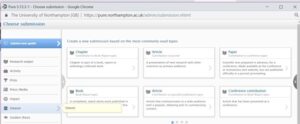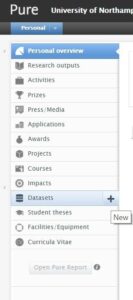Guidance on completing metadata fields in PURE
Details
This section collects basic information about the dataset. The information you provide here will help you and others find the record again in Pure and other systems.
Title
Provide a name for your dataset that would make sense to someone searching for data, for example ‘Dataset for [journal article name]’
Description
Describe your dataset so another researcher could decide if it was relevant to their research. Note, you will have an opportunity to provide a lay summary and detailed documentation when you edit the public facing record, so you do not have to provide them here.
Collection date(s)
Provide the start and end date of your period of data collection or of your study period.
People
This section collects information about the people responsible for the dataset.
Select ‘Add person’, or ‘Add organisational unit’ if you want to add a whole organisation as a contributor.
For each person you add you will be asked to provide their role and affiliation.
Role
Use ‘Creator’ to include that person’s name in the citation for the dataset, use another role (for example Data Collector, Project Leader, Rights Holder) to acknowledge a person’s contribution without including them in the citation
You can add the same person multiple times if they had several roles.
Affiliation on the dataset
For each person provide their affiliation at the time that the dataset was created. This field should be automatically generated but you may need to update it if the person has since moved to a different department.
Dataset managed by
Check that the ‘Managing organisational unit’ is the department responsible for the dataset.
Data availability
This section collects information about where the data will be kept long term, and from where it will be available.
Publisher
This refers to where you will archive your dataset. If your data are deposited with an external repository, or you plan to do so, select ‘Change publisher’ and provide the repository name
Digital Object Identifier (DOI)
- if your dataset already has a DOI, include it here
- if your dataset does not have a DOI leave this section blank
- if you are depositing your data in Pure and it does not yet have a DOI, the Research Support Team will ensure a DOI is minted for your dataset after you have completed this form).
Locally Held Data
If you have non-digital or other local data that cannot be uploaded to Pure provide:
- a description of the data
- where that data will be kept
- how that data can be accessed
- the medium on which they are recorded (e.g. paper)
- Provide links to any secondary versions of the dataset, such as copies on a project website or another repository or links to closely related resources.
Publication date
If your dataset has already been published, give the date here. Otherwise, input the current year.
Access contact details
This is the main contact person for the dataset and must be one of the people listed as a ‘Creator’ in the ‘People’ section. If this is left blank we will assume that the first named ‘Creator’ of the project is the main contact.
Temporal coverage
If your dataset relates to period of time before you collected it (for example, animal records from 1850-1905), enter the date range here.
Geographical location
The information in this section enables your dataset to be found in searches for data about a particular area/place. Leave this section blank if your dataset contains information about vulnerable groups (for example, endangered species) or if location is not relevant.
Geographical coverage
Use this field to describe the location of data in words (e.g. Northampton, UK).
Geospatial point and Area
If it is appropriate and if the data were collected at a specific point, select ‘Point’ and enter the latitude and longitude separated by a comma, do the same for area.
Legal / ethical
In this section you must tell us about any data protection, ethical, commercial or sensitivity issues that relate to your dataset. If you are unsure email pure@northampton.ac.uk with the subject Datasets – Ethics for advice before saving your item for validation. (Save dataset as entry in progress until matter resolved).
Data protection
Tick this box if your dataset contains personal data unless the data has been fully anonymised.
Provide details about whether you have gained consent from participants for data sharing, and if so under what terms (for example, data anonymisation or data sharing agreements).
Ethical approval
Tick this box if your research required ethical approval.
Provide details on whether this affects your ability to share the data.
Commercial constraints
Tick this box if commercial considerations constrain your ability to share the data.
In the text box that appears provide further details of these constraints (e.g. embargo time to allow commercialisation). If you have been working with a commercial partner, the constraints should be clear from the collaboration agreements.
Consult with RIFS (Research Information & Funding Services) for more information.
Sensitive
Tick this box if your dataset contains material which may be considered to be sensitive for any reason not already covered (for example, locations of endangered species, fragile ecosystems, genetically-modified crops or animal testing units or data subject to non-disclosure agreements).
Provide details of the nature of this sensitivity and the restrictions that should be put in place for the dataset or dataset record.
Relations to other content
Use the ‘Project’ button to link your dataset to a project. We need to know this in order to tell who funded the work.
You can also link your dataset to other outputs: – publications (articles, chapters) that make use of the data – related datasets (for example, from the same project or programme of work)
Visibility
This section determines whether the dataset will appear on your Research Profile. Set it to ‘Campus’ to begin with. We will change it to ‘Public’ for you later.
If you have indicated in the ‘Legal/ethical’ section that the dataset is so sensitive that even the record describing it cannot be made public change this setting to ‘Confidential – restricted to associated users and editors’. This will mean that the record will remain in Pure but will not be publicly accessible.
Does data have to be open?
In most cases the default setting for deposited data is open access. However, there are circumstances where access to data can be restricted either permanently or for a limited embargo period.
Common circumstances for restriction include:
- Data Protection
- Ethical approval
- Commercial constraints
- Sensitive content
- Moratorium on thesis data
- Period of exclusivity for data creators.
The University of Northampton works to the ethos of FAIR (Findable, Accessible, Interoperable, Reusable) Data, ensuring that data is as open as possible, but as closed as necessary.
Pure offers a range of data visibility and access options to support your data and research requirements, email the Research Support Team at pure@northampton.ac.uk for further advice.
External data deposit
Research data produced at the University of Northampton should be deposited in PURE unless circumstances determine that a more appropriate repository is chosen, these include:
- The funder of the research mandate a specific data repository
- In joint research projects the data is deposited in the repository of a collaborator
- A specialist or disciplinary focused repository exists that provides data with greater impact
- Certain types of data, typically software or code, are better served in a version control repository such as GitHub.
The only local requirement for external deposit is that a corresponding dataset record must be created in Pure which references and links to the external repository.
If you are uncertain where to deposit your dataset/s please contact the Research Support Team at pure@northampton.ac.uk with the subject Datasets.

